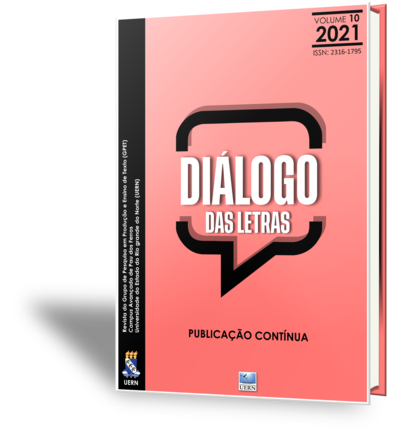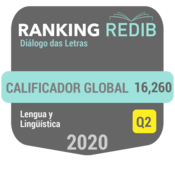Um guia de estratégias de leitura para o texto hipermodal em língua estrangeira: foco na hipermodalidade e no afeto
DOI:
https://doi.org/10.22297/2316-17952021v10e02130Keywords:
Texto hipermodal, Leitura em língua estrangeira, Estratégias de leituraAbstract
Today's changes and challenges caused by the COVID-19 pandemic added to the need for work on language and the use of technologies, mainly on hypermodal text reading, demand studies that focus on Digital Literacy. In this context, this work proposes a guide of strategies to read hypermodal text in a foreign language (FL) considering hypermodality and affect. To accomplish this, a conception of social-interactional reading is adopted, which understands that the reading process occurs through the interaction between the text and the reader within a social practice that considers the construction of meanings based on socio-historical-ideological and cultural factors. Still, in the theoretical scope, the research is based on Lemke's (2002, 2010) and Selber (2004) studies on Multiliteracies related to technologies. To develop the hypermodal text reading strategies guide, the present work is based on the following theories: the Principles of Presentation, Orientation and Organization proposed by Lemke (2002); the Theory of the Neural Mechanism of Affect developed by Schumann (1997) and the Intersemiotic Coherence Analysis Model, reformulated by Gomes (2019). The guide provides theoretical and practical support for reading the hypermodal text in a foreign language, as it can help learners read the hypermodal text in FL and E/FL teachers in their educational practices.
Downloads
References
ALVES, F. A. Os caminhos de conhecer, refletir e experienciar o letramento digital: o discurso discente sobre a prática na formação inicial de professores. 2019. 140f. Dissertação em Linguística - Universidade Federal de Juiz de Fora, Juiz de Fora, 2019.
BRAGA, D.B. Um alerta: navegar é preciso. In: BRAGA, D. B. (org.). Ambientes digitais: reflexões teóricas e práticas. São Paulo: Cortez. 2013. p. 56-58.
COIRO, J.L. Rethinking comprehension strategies to better prepare students for critically evaluating content on the Internet. The NERA Journal, v. 1, n. 39, p. 29-34, 2003.
COSCARELLI, C.V. Navegar e ler na rota do aprender. In: COSCARELLI, C. V. (org.). Tecnologias para aprender. São Paulo: Parábola Editorial, 2016. p. 61-80.
COSCARELLI, C. V.; NOVAIS, A. E. Leitura: um processo cada vez mais complexo. Letras de Hoje, v. 3, n. 45, p. 35-42, 2010.
GARDENER, R. C.; LAMBERT, W. E. Motivational variables in second language acquisition. Canadian Journal of Psychology, v. 13, p. 266–272, 1959.
GARDNER, R. C. Motivation and Second Language Acquisition: the social-educational model. New York: Peter Lang, 2010.
GOMES, L.F. Coerência Intersemiótica: um estudo aplicado de três modelos de análise das relações imagem texto. In: AZEVEDO, I.C.M. & COSTA, F. R. (org.), Multimodalidade e práticas de Multiletramentos no ensino de línguas. São Paulo: Blucher. 2019. p. 249-263.
LEMKE, J. L. Travels in Hypermodality. Visual Communication, v. 1, n. 3, p. 299-325, 2002.
LEMKE, J. L. Letramento metamidiático: transformando significados e mídias. Trabalhos em Linguística Aplicada, v. 2, n. 49, p. 455–479, 2010.
LEMKE, J. L. Multimedia and discourse analysis. In: GEE, J. P. & HANDFORD, M. (org.), The Routledge handbook of discourse analysis. New York: Routledge. 2013. p. 105-115.
MONTEIRO, A. M. V.; RIBEIRO, P. N. S. Realidade virtual no ensino de vocabulário de inglês: um estudo exploratório sobre afeto no uso da tecnologia. Trabalhos em Linguística Aplicada, v. 2, n. 59, p. 1310-1338, 2020.
SAITO, F. S.; SOUZA, P. N. (Multi)letramento(s) digital(is): por uma revisão de literatura crítica. Linguagens e Diálogos, v. 2, n. 1, p. 109-143, 2011.
SAITO, F. S. Aprendizagem de vocabulário de inglês como língua estrangeira em ambiente hipermídia: efeitos da retenção lexical a curto e longo prazo em uma abordagem de ensino e aprendizagem lexical implícita. 2015. 146f. Tese (Doutorado em Linguística) – Universidade Federal de Juiz de fora, Juiz de Fora, 2015.
ROJO, R.; BARBOSA, J. Hipermodernidade, multiletramentos e gêneros discursivos. São Paulo: Parábola Editorial, 2015.
SANTAELLA, L. Navegar no ciberespaço: o perfil cognitivo do leitor imersivo. São Paulo: Paulus, 2004.
SCHUMANN, J. H. Language learning: the neurobiology of affect in language. Malden: Blackwell Publishers, 1997.
SELBER, S. A. Multiliteracies for a digital age. Carbondale: SIU Press, 2004.
Downloads
Published
How to Cite
Issue
Section
License
Copyright (c) 2021 Diálogo das Letras

This work is licensed under a Creative Commons Attribution 4.0 International License.
A Diálogo das Letras não se responsabiliza por conceitos e opiniões emitidos pelos autores, tampouco manifesta, necessariamente, concordância com posições assumidas nos textos publicados. Além disso, os dados e a exatidão das referências citadas no trabalho são de inteira responsabilidade do(s) autor(es). Ao submeterem seus trabalhos, os autores concordam que os direitos autorais referentes a cada texto estão sendo cedidos para a revista Diálogo das Letras; ainda concordam que assumem as responsabilidades legais relativas às informações emitidas.


















